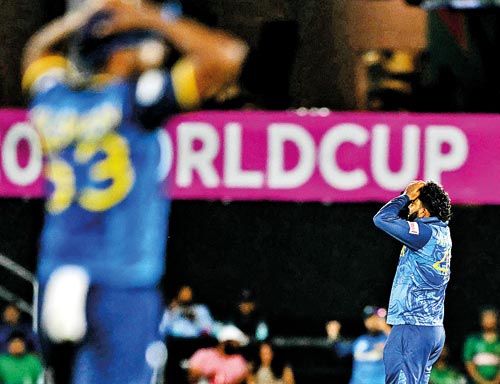The outcome of revolving instead of evolving

The picture says it all -- a common gesture of Sri Lankan cricket fans when their team fails miserably, now inherited by T20 skipper Wanindu Hasaranga, after his team's loss to Bangladesh - AFP
Sri Lanka embarked on their ongoing T20 World Cup journey with buoyant confidence, fueled by triumphant outings against Zimbabwe, Afghanistan, and Bangladesh in their preceding series. These victories not only uplifted the spirits of selectors, team management, and players but also ignited a fervent belief that a second T20 title was well within reach for the islanders.
However, the initial wave of optimism swiftly gave way to a stark reality as the tournament unfolded across the United States and the West Indies. The 2014 champions found themselves teetering on the brink, desperately reliant on the missteps of other teams in their group to secure a slim chance of advancing to the Super Eight stage.
Their dismal start, marked by successive losses to South Africa and Bangladesh, underscores the formidable challenges they confront in the dynamic landscape of T20 cricket—a format that has fundamentally transformed the game.
The glaring lack of adaptability and strategic acumen further compounds Sri Lanka’s plight, casting doubt upon the players’ capacity to withstand the pressures of high-stakes encounters. Former Sri Lankan cricketer Sudat Pasquel rightly identified the root issue plaguing Sri Lanka’s T20 campaign: their failure to evolve alongside the evolving demands of the format since their triumph in 2014.
“But, the probable outcome should not be a surprise,” wrote Mr. Pasquel on facebook.
While past successes may have been characterised by unorthodox tactics and individual brilliance, modern T20 cricket demands a more measured and consistent approach. Relying solely on unconventional methods and sporadic brilliance is no longer tenable in the face of teams that prioritise consistency and strategic flexibility.
“SL has not made the adjustments needed to keep up with the innovations in the T20 format since winning the WC in 2014. SL, or any other team for that matter, is not going to win tournaments at this level by banking on freaks and unorthodox players. Most teams are prepared for all eventualities”, he explained.
Puzzling selection choices further exacerbate Sri Lanka’s woes. The inclusion of two unorthodox bowlers with sling-arm actions, Nuwan Thushara and Matheesha Pathirana, at the expense of proven performers like Dushmantha Chameera or Dilshan Madushanka raises eyebrows, particularly given pitch conditions favouring bounce and carry. While Thushara’s commendable performance salvaged some pride against Bangladesh, the lack of support from the rest of the bowling unit compounded Sri Lanka’s woes as they suffered their second consecutive defeat.
Equally confounding is the preference for long-format specialist Dhananjaya de Silva over seasoned white-ball cricketers like Janith Liyanage or the dynamic match-winner Kusal Janith Perera. Such decisions underscore a disconnect between the selectors’ vision and the team’s immediate requirements, further eroding confidence in the decision-making hierarchy.
However, perhaps the most glaring deficiency in Sri Lanka’s lineup is the absence of power hitters capable of single-handedly shifting the momentum of a match. Despite four seasons of their own T20 league, Sri Lanka has failed to produce game-changing talents akin to those nurtured by more established competitions like the IPL. The reliance on ageing stalwarts and inconsistent performers to fulfill pivotal roles underscores the dearth of explosive talent within the squad.
The leadership dynamics within the team also warrant scrutiny, with questions surrounding Wanindu Hasaranga’s captaincy tenure. Hasaranga’s perceived rigidity in team selection and strategic approach has exacerbated the team’s woes, emphasising the urgent need for a reassessment of leadership structures.
In the aftermath of their recent defeat, team manager Halangode acknowledged the challenges posed by unfamiliar conditions during their preparation in the United States. Despite early arrival and efforts to acclimatise, inclement weather and substandard practice facilities hampered their readiness for the tournament. This is despite reaching the United States two weeks before the start of the tournament.
Since the 2019 World Cup in England, Sri Lanka has participated in five world limited over tournaments—two ODI World Cups and three T20 World Cups—yet each has only deepened the nation’s cricketing woes, underscoring the imperative for a comprehensive overhaul of both cricketing and administrative systems to revitalise Sri Lanka cricket.
Failure to do so could spell the demise of Sri Lankan cricket, if it hasn’t already begun.


